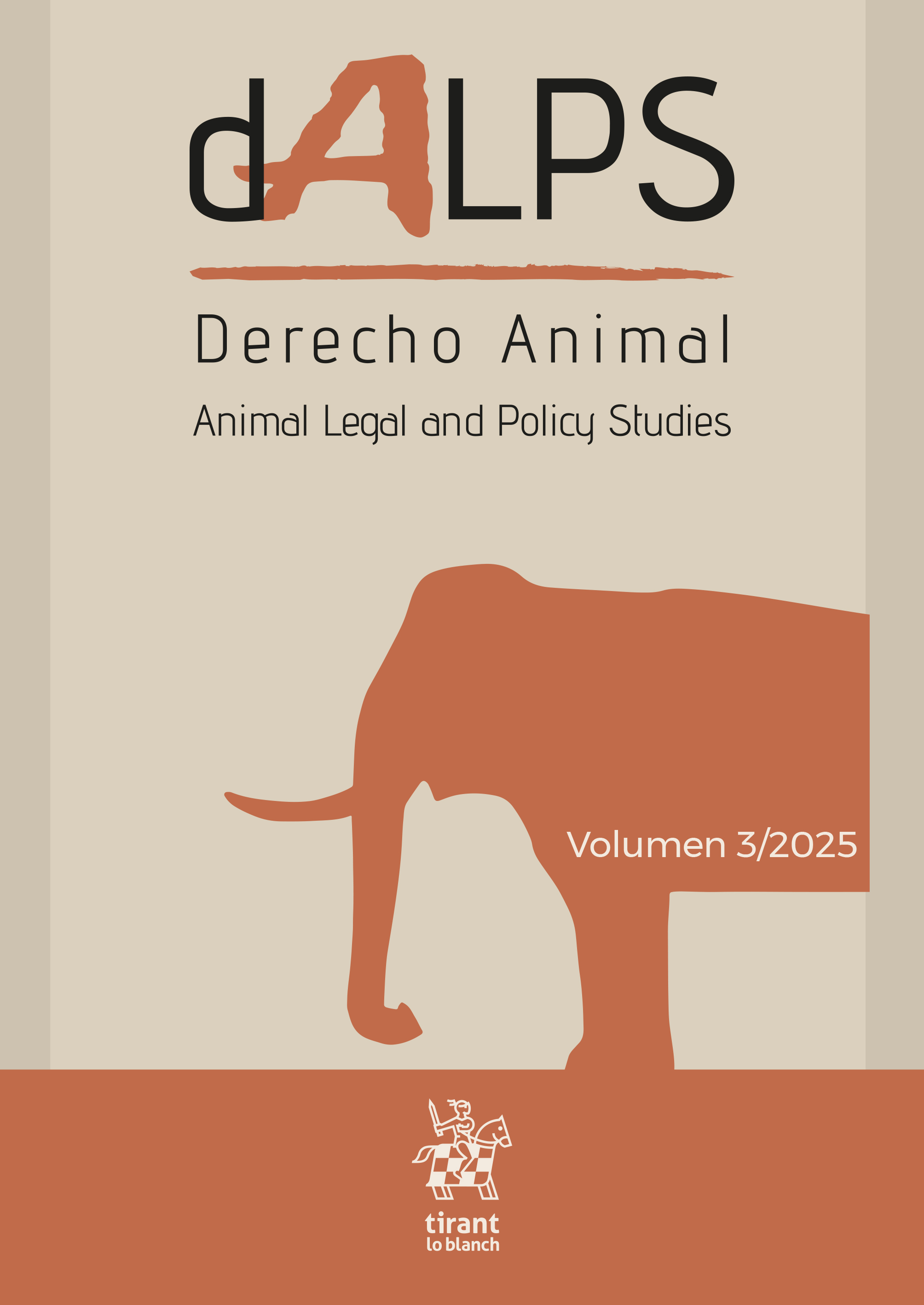Non-human animals in the indigenous cosmovision: between rights and ethics
DOI:
https://doi.org/10.36151/DALPS.059Keywords:
animal rights, indigenous rights, subjects of law, indigenous cosmovision, animal ethicsAbstract
The relationship between indigenous peoples and animals has historically been fundamental to the worldview of many indigenous communities around the world. For these peoples, hunting and fishing are not only means of subsistence and spirituality but also deeply rooted cultural practices. This cultural and spiritual bond is protected by international treaties such as the International Labour Organization's (ILO) Convention 169, as well as national legislation that guarantees the right to maintain traditional practices and cultural self-determination. In contemporary contexts, however, these practices have come under increasing ethical and legal challenge, particularly from movements advocating for the recognition of animals as sentient beings with rights. From this perspective, hunting, fishing, and other traditional uses of animals are seen as incompatible with the principles of respect for the individual rights of animals. This tension raises complex and urgent questions. Using an interdisciplinary and comparative methodology that combines normative and philosophical analysis, the tensions between animal rights and indigenous cultural rights are analysed. This work does not aim to provide definitive answers but rather to explore these issues and encourage an open debate.
Downloads
References
AIME, M. Il primo libro di Antropologia (Torino, 2008).
ARANZADI, HABERLANDT, M. Etnografía (1926).
BARSH, R. Taking Indigenous Science Seriously, en Biodiversity in Canada: Ecology, Ideas and Action. Ed. Stephen Bocking (Peterborough 1999), 166.
BECERRA, K., Relación entre los pueblos Indígenas de las Américas y los demás animales. Aprendizajes y propuestas para el derecho, en DALPS (Derecho Animal-Animal Legal and Policy Studies) (2024) 58-80. DOI https://doi.org/10.36151/DALPS.017.
BELTRAN, J. Pueblos Indígenas y Tradicionales y Áreas Protegidas: Principios, Directrices y Casos de Estudio, en UICN (2001) 139.
BENTHAM, J. An introduction to the Principle of Moral and Legislation, en Oxford University Press (Oxford, 1996).
BERROS, M. V. Ética animal en dialogo con recientes reformas en la legislación de países latinoamericanos, en Revista de Bioética y Derecho 33, 82-93. https://doi.org/10.1344/rbd2015.33.11566.
CORREA MAUTZ, F. La filosofía indígena desde la filosofía académica latinoamericana, en Veritas 57 (2024) 79-102. http://dx.doi.org/10.4067/S0718-92732024000100079.
DE LA TORRE TORRES, R. El bienestar animal como principio constitucional implícito y como límite proporcional y justificado a los derechos fundamentales en la Constitución mexicana en dA Derecho Animal: Forum of Animal Law Studies 11/3 (2020) 152–161. https://doi.org/10.5565/rev/da.506.
ERRICO, S. Los derechos de los pueblos indígenas en el contexto de la pesca y la acuicultura, en Instituto Danés de Derechos Humanos (2021).
FERNANDEZ DOS SANTOS, C. ¿Pueden los animales ser sujetos de derechos? en Abogacía Española (2023) https://www.abogacia.es/publicaciones/blogs/blog-de-derecho-de-los-animales/pueden-los-animales-ser-sujetos-de-derechos/.
FOY, P. La constitución y el animal: Aproximación a un estudio comparado, en Foro Jurídico 13 2014 155-174.
FRANCIONE, G. Introducción a los derechos de los animales: ¿tu hijo o el perro? (Philadelphia 2000).
FRANCIONE, G. Rain without thunder. The ideology of the animal rights movement (Philadelphia 1996).
FRANCIONE, G., CHARLTON, A. Animal Rights: The Abolitionist Approach. (Coppell 2015).
FRAZER, J. G. Totemism and Exogamy. Vol. I (2013).
GARCÍA LABRADOR, J. ¿Es posible tomarse el animismo interculturalmente en serio? en Martins, D. V.y Knaap, C. (eds.) Etnogênese e Interculturalidade no contexto latino e Ibero-americano (2021) 333-354.
GLYNN-MCDONALD, R. Connection to Animals and Country, en https://www.commonground.org.au/article/connection-to-animals-and-country (2020).
GONZÁLEZ GALLINAS, E. Relaciones con los animales en las culturas nativas de Norteamérica, en Soberanía alimentaria, biodiversidad y culturas 28 (2017) 26–29.
GONZÁLEZ, I., SANDOVAL, A. El riesgo de embargabilidad de los animales en los juicios ejecutivos y procedimientos de liquidación. Situación actual en Chile, en DALPS (Derecho Animal-Animal Legal and Policy Studies) (2024) 82–102. https://doi.org/10.36151/DALPS.018.
GREBE, M. E. El culto a los animales sagrados emblemáticos en la cultura aymara de Chile, en Revista Chilena de Antropología 8 (1990) 35-51.
HERREROS, P. Tribus y animales se tratan de igual a igual. En Yo, Mono (2017) https://www.elmundo.es/blogs/elmundo/yomono/2017/01/14/tribus-y-animales-se-tratan-de-igual-a.html.
HOPENHAYN, M., Y BELLO, A. Discriminación étnico-racial y xenofobia en América Latina y el Caribe. Comisión Económica para América Latina y el Caribe, CEPAL, 2001.
HORTA, O. Método y justificación en ética: antropocentrismo definicional e intuiciones morales, en Ágora 26(1) (2007), 129-137.
HORTA, O. What is Speciesism? en Journal of Agricultural and Environmental Ethics 23 (2010), 243-266.
INGOLD, T. The animal in the study of humanity. En What is an animal? (London, 1994) 84-99.
KELSEN, H. Teoría pura del Derecho (México 1982) 178.
KYMLICKA, W., DONALDSON, S. Derechos Animales y Derechos Indígenas, en Devenires, XXI, 42 (2020) 148-186.
LÉVI-STRAUSS, C. El totemismo en la actualidad. (México, 1965).
LIRA, C. El animal en la cosmovisión indígena, en AISTHESIS: Revista Chilena de Investigaciones Estéticas 30 (1997) 125–142. https://revistaapuntes.uc.cl/index.php/RAIT/article/view/5700.
MILL, J.S. Dr. Whewell on Moral Philosophy, en Collected Works Vol X. (London 1969), 165-201.
MILL, J.S. Utilitarianism, en Collected Works Vol X. (London 1969), 203-259.
MILLÁN, S. Animales, ofrendas y sacrificios en dos pueblos indígenas de Mesoamérica en Dimensión Antropológica 62 (2014) 7–24. https://www.revistas.inah.gob.mx/index.php/dimension/article/view/5543/6390.
NAVA ESCUDERO, C. Los animales como sujetos de derecho” en dA. Derecho Animal (Forum of Animal Law Studies) 10/3 (2019) 47–68. https://doi.org/doi.org/10.5565/rev/da.444.
NAVA ESCUDERO, C. Los derechos de los animales. Una visión jurídica, en UNAM (Mexico 2023). https://doi.org/10.1093/acprof:oso/9780195305104.003.0002.
NEURATH, J. Cacería ritual y sacrificios huicholes: entre depredación y alianza, intercambio e identificación. En Journal of the Society of Americanists 94-1 (2008) DOI: https://doi.org/10.4000/jsa.9873. 251-283.
NUSSBAUM, M. Beyond ‘Compassion and Humanity’. Justice for Non-human Animals, en
NUSSBAUM, M. Las fronteras de la justicia. Consideraciones sobre la exclusión (Barcelona 2007).
RAWLS, J. A Theory of Justice (Cambridge 1971).
REGAN, T. The Case for Animal Rights (Berkeley 1983).
ROJAS CASTILLO, J., WEIDENSLAUFER, C. Nueva Zelanda: el Estado y su relación con el pueblo Maorí, en Biblioteca del Congreso Nacional de Chile (2023).
ROMERO CAMPOY, D. Pluralismo cultural y la cuestión animal: tres casos de conflicto, en dA Derecho Animal: Forum of Animal Law Studies (2021) 105-129.
ROWLAND, M. Animal Rights: A philosophical defence (London 1998).
RYDER, R. Experiments on Animals. Eds GODLOVITCH, S., GODLOVITCH, R., HARRIS, J. Animals, Men and Morals: An Inquiry into the Maltreatment of Non-humans, en Oxford (1971) 41-82.
SALMÓN, E. Kincentric Ecology: Indigenous Perceptions of the Human-Nature Relationship en Ecological Applications 10/5 (2000) 1327–1332. https://doi.org/10.2307/2641288.
SINGER, P. Animal Liberation (London 2002).
SPAGNA, F. Animali spirituali. Tradizioni native del Canda subartico, en Atti del Convegno Visioni e interpretazioni del Nord. Artico e Subartico (2006) 41-51.
SUNSTEIN, C. R., NUSSBAUM, M. C (Eds) Animal Rights: Current Debates and New Directions. Oxford Academic (2004) 299-320.
WISE, S. M. Animal rights, one step at a time, en SUNSTEIN, C. R., NUSSBAUM, M. C. (Eds). Animal Rights: Current Debates and New Directions. Oxford Academic (2005).
ZUKERAN, P. El mundo del animismo (2004).
United States v. State of Washington, 384 F. Supp. 312 (Western District of Washington 1974).
Supreme Court of Canada, R. v. Sparrow, (1990) 1 S.C.R. 1075. https://scc-csc.lexum.com/scc-csc/scc-csc/en/item/609/index.do
Supreme Court of Canada, R. v. Van der Peet (1996), in https://decisions.scc-csc.ca/scc-csc/scc-csc/en/item/1407/index.do.
Naciones Unidas, Consejo Económico y Social. Foro Permanente para las Cuestiones Indígenas (2004).
Gobierno de Canadá, in https://www.rcaanc-cirnac.gc.ca/eng/1100100028574/1529354437231
Gobierno de Canadá, in https://www.rcaanc-cirnac.gc.ca/eng/1360948213124/1544620003549
Downloads
Published
How to Cite
Issue
Section
License
Copyright (c) 2025 DALPS (Derecho Animal-Animal Legal and Policy Studies)

This work is licensed under a Creative Commons Attribution-NonCommercial-NoDerivatives 4.0 International License.









